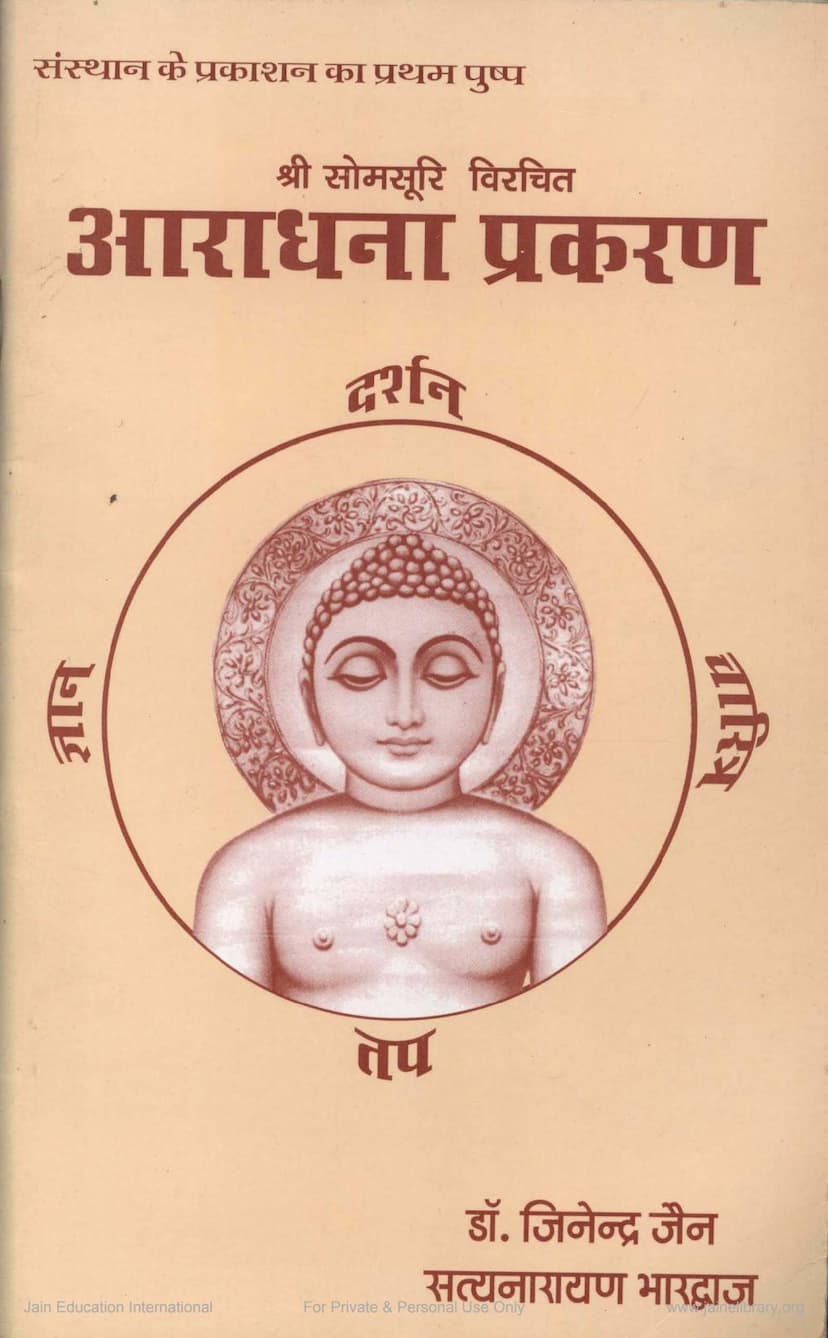Aradhana Prakarana
Added to library: September 1, 2025

Summary
Here's a comprehensive summary of the Jain text "Aradhana Prakarana" based on the provided pages:
Book Title: Aradhana Prakarana Author: Somesuri Acharya Editors/Translators: Dr. Jinendra Jain, Satyanarayan Bharadwaj Publisher: Jain Adhyayan evam Siddhant Shodh Samsthan Jabalpur
Overall Purpose and Content:
The "Aradhana Prakarana" is a significant Jain text authored by Somesuri Acharya, now presented in an edited and translated form by Dr. Jinendra Jain and Satyanarayan Bharadwaj. Published by the Jain Adhyayan evam Siddhant Shodh Samsthan in Jabalpur, this work is described as the "first bloom" of the institution's publications. The text, written in Prakrit, focuses on the essence of Aradhana (devotional practice or worship), outlining key principles for spiritual progress and liberation (Nirvana). It emphasizes the practical aspects of Jain dharma and the importance of sincere devotion and adherence to its tenets.
Key Themes and Concepts:
- The Nature of Aradhana: The book defines Aradhana as a means to achieve liberation, involving the contemplation of the four core elements of refuge (Chatuh-sharan), the renunciation of harmful practices (Ayatana and Asatana), and the approval of virtuous deeds (Krita-karyas). It highlights Aradhana as a path to self-welfare and the welfare of others.
- The Four Pillars of Aradhana: While not explicitly detailed as four distinct chapters, the text emphasizes Dharshan (right faith), Gyan (right knowledge), Charitra (right conduct), and Tapa (austerity) as central to devotional practice. These are presented as aspects that lead to spiritual upliftment.
- The Five Parmeshthis (Pancha Parmeshthi): The text strongly emphasizes the reverence and worship of the Five Parmeshthis – Arihant, Siddha, Acharya, Upadhyaya, and Sadhu. The Namokar Mahamantra (Navkar Mantra) is highlighted as the most potent and auspicious mantra, essential for seeking worldly and ultimate liberation.
- Ethical Conduct and Renunciation: The book details the renunciation of eighteen types of sins (Ashtadasha Papagana), the importance of controlling passions (Kashayas), and the abandonment of harmful actions. It advocates for forgiveness, compassion, and peaceful coexistence with all living beings.
- The Four Refuges (Chatuh Sharan): The text identifies the four ultimate refuges for all living beings:
- Arihant: Those who have destroyed their destructive karmas, are detached from the world, and guide towards liberation.
- Siddha: Those who have renounced the world, are free from the cycle of birth and death, and have attained the highest state of liberation.
- Sadhu (Muni): Those who are holders of great vows, control their passions, remain equipoised in pleasure and pain, and treat everything equally.
- Dharma: The universal law that benefits the entire world, as proclaimed by the Kevalins (omniscient beings), and which helps one cross the ocean of existence.
- Critique of Non-Virtuous Actions: The text includes extensive verses expressing remorse and seeking forgiveness for various shortcomings and wrongdoings, including:
- Neglecting the practice of the four Parmeshthis.
- Improper conduct towards Jain temples, idols, and scriptures.
- Violence against the six types of living beings (Sad-Jeevanikaya).
- Speaking untruths, theft, sexual misconduct, anger, pride, deceit, greed, attachment, hatred.
- Disrespecting sacred texts and practices.
- Failing to perform austerities and follow vows.
- Praise of Virtuous Actions: The text also encourages the approval and adoption of good deeds, such as devotion to the Parmeshthis, adherence to the Namokar Mahamantra, and practicing righteous conduct.
- The Significance of the Namokar Mahamantra: The book repeatedly emphasizes the power and importance of the Namokar Mahamantra, stating that it is the key to overcoming obstacles, achieving worldly happiness, and ultimately attaining Nirvana.
- Literary and Linguistic Aspects:
- Language: The original text is in Prakrit, specifically the Maharashtri Prakrit dialect. The editors have meticulously edited and translated it, providing the original text with "Anvay" (grammatical arrangement) and Hindi translation.
- Structure: The work comprises 70 verses (Gathas). The publication includes a detailed introduction, analysis of the manuscripts, a study of the themes, a discussion of poetic elements (Rasa, Chhand, Alankar), and linguistic analysis.
- Poetic Elements: The text utilizes various poetic devices (Alankaras) such as Kavyalinga, Paryaya, Parikar, Rupak, Visheshokti, and Vimbhana, which enhance its literary value. The primary meter used is the "Gatha" (Arya Chhand).
- Manuscript Details: Two manuscripts of the text were found in the Jain Vishva Bharati Institute library, cataloged under numbers 1566 and 1591. Manuscript 'A' is noted as having 17 pages and 9 folios, with four lines per page including commentary. Manuscript 'B' has a slightly varied line count per page and includes the scribe's details, dating the completion to Samvat 1665 (1608 CE). Manuscript 'A' was chosen as the primary manuscript for this edition.
Significance of the Publication:
This publication by the Jain Adhyayan evam Siddhant Shodh Samsthan is significant as it makes a valuable Jain scripture accessible to a wider audience. It contributes to the preservation and study of Prakrit literature and Jain philosophy. The detailed commentary, translation, and scholarly analysis by the editors provide deep insights into the teachings of Somesuri Acharya and the practices of Jain Aradhana. The catalog link provided leads to resources that further elaborate on this esteemed work.